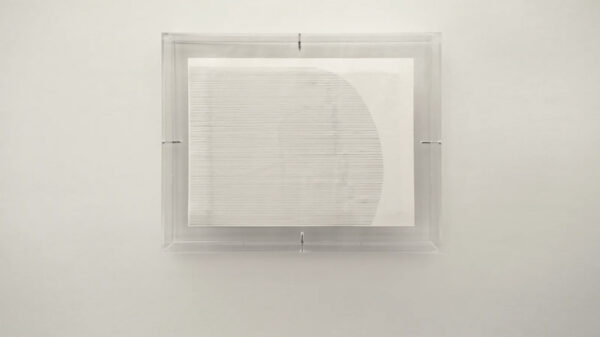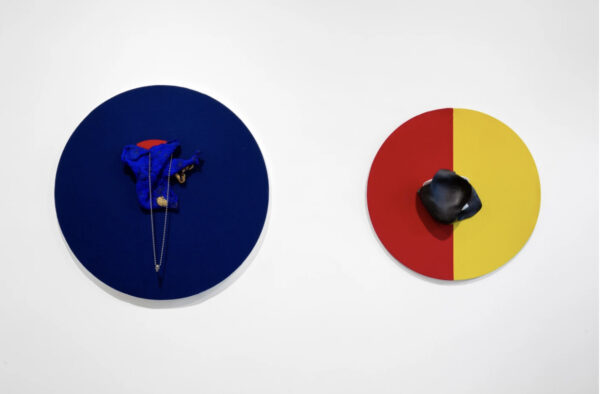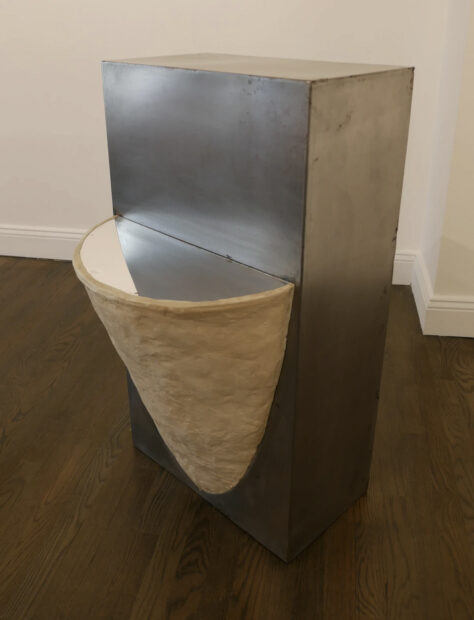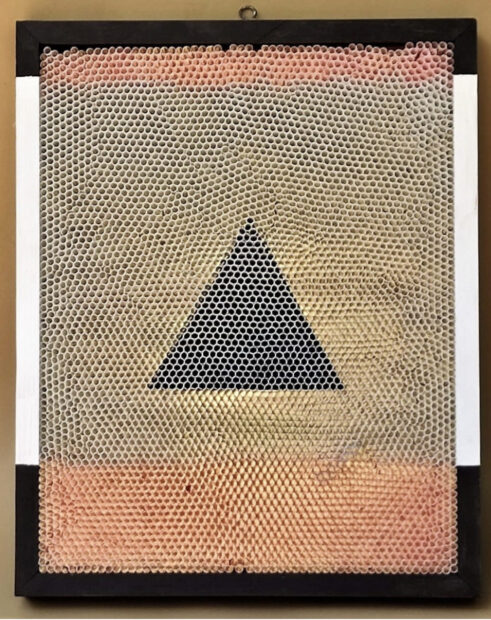Para leer este artículo en español, por favor vaya aquí. To read this article in Spanish, please go here.
To read about the San Antonio presentation of this exhibition, go here.

Installation image of “I Am Not Your Mexican” at Ruiz-Healy Art in New York City. Photo: Daniel Terna.
The first work that catches my eye at Ruiz-Healy Art’s New York gallery is a small sketch by Teresa Serrano, which vaguely resembles bacchus grapes. Looking closer, little notes indicate otherwise: “leather,” “stainless steel,” “fiberglass.” What exactly am I looking at?
“We have a sculpture that relates to this work in San Antonio,” gallery owner Patricia Ruiz-Healy points out. The sculpture, which is currently 2,000 miles from this sketch, is part of the artist’s Goddess of Fertility series, a nod to Post-Minimalism — and its pioneer Eva Hesse. Serrano’s sketch (and sculpture) bear a striking resemblance to Hesse’s Untitled or Not Yet (1966), a three-dimensional abstract work with similar drooping objects, charged with psychological associations and feminist allure. Like everything else in this group exhibition, it possesses a warmth and expressiveness that softens the steely cube of Minimalism.

Fernando Polidura, “CF Eleven,” 2023, human hair embroidered on cotton paper, 9.3 x 11.8 x 2.4 inches
I Am Not Your Mexican is running concurrently in Ruiz-Healy Art’s New York and San Antonio galleries this summer, featuring work by Jesse Amado, Mathias Goeritz, Hersúa, Willy Kautz-Jippies Asquerosos, Fernando Polidura, and Teresa Serrano. The show’s title comes from Amado’s series of the same name, which references the 2016 film I Am Not Your Negro, based on the notes of James Baldwin’s final book. Baldwin’s unfinished manuscript offers an unblinking assessment of racism in America; Amado’s decision to repurpose its title seems wholly intentional.
Yet the works featured in I Am Not Your Mexican echo a movement more often regarded for its purity in aesthetics than its take on politics. If Post-Minimalism aims to deconstruct the cold, hard (white, male) facts of Minimalism, perhaps I Am Not Your Mexican is more emotionally loaded than it initially lets on. European influences in Modern Art have readily been amalgamated and informed by other cultures — offering new (and old) cultural input. The show’s curator, Eduardo Egea, calls Mexico a “rich laboratory” that has, for decades, subverted Minimalism through its Post-Minimalist art.
Egea, who spoke to me via email, expressed that certain “cultural openings” made it possible for an artist like Eva Hesse to build upon the Western canon — which paved the way for others to further transform its influence (and dominance) in Modern Art. Hesse, whose untimely death in 1970 at the age of 34 cut short her own Post-Minimalist experimentation, left a mark that can be traced throughout these five artists’ works.
Serrano’s sculpture, Womb (1994), on view in the New York gallery, features a metal box reminiscent of a Donald Judd sculpture — and Judd is expecting. Bulging out from the box, a ceramic belly carrying, who else, but you. (A mirror is affixed to the womb.) Abstract as the sculpture may be, a certain bodily inevitability overtakes its industrial form, pitting feminine and masculine energies against each other in a “formalism versus symbolism” grudge match. Serrano, now in her late 80s, is the only female artist in the show. According to an online bio, she pursued art only later in her life, relocating to New York from Mexico City after raising nine children and ending her longtime marriage.
Womb is flanked by Willy Kautz/Jippies Asquerosos’ Noli Me Tangere 2020 (“Do Not Touch Me” in Latin), and Mathias Goeritz’ Mensaje (1958-1962): two monochromatic wall pieces made of gilded materials that evoke colonialism, capitalism, even Catholicism. Mensaje — Spanish for “message” — is a hammered brass panel that embodies the repetition of Minimalism but with a personal, artisanal touch. Like Kautz’s gold-leaf work, the main material used in Mensaje feels meaningful and contextual. When I asked Egea if certain works were specifically chosen for each gallery, in each city, he answered no — but with a question: “Is it easier to read the religious and spiritual connotation of gold in Mathias Goeritz by the Latino community in San Antonio than the economic burden of Willy Kautz’s gold in New York?”
Goeritz, who died in 1990, had emigrated to Mexico in 1949 after leaving Berlin eight years earlier during the war. “He brought an international avant-garde language to Mexico, but it was related to Mexico,” says Ruiz-Healy. “He used a lot of gold in his work as a color choice — which has been a big influence on the work of Willie.” Of the five artists in the show, Goeritz and Kautz have the clearest aesthetic connection, yet there is overlap everywhere.

Installation image of Jesse Amado, “I Am Not Your Mexican, A Rapist,” 2023, (left) 100% virgin wool felt, acrylic on chicharrón, silver chain, 30.5 x 30.5 x 4 in.; and Jesse Amado, “Take Out Brisquet Burger, 2023 (right), virgin wool felt and acrylic styrofoam, 24 x 24 x 4 inches. Photo: Daniel Terna.
Across the way, two works by San Antonio artist Jesse Amado — including A Rapist (2023), from the series in which this show takes its title — break up the room’s mixed metals with intense primary colors. Both works are circular, installed on the wall like plates, and each plate contains a rich meal: an adorned pork rind on one, a mangled burger container on the other. Neither are recognizable, even up close. Amado has an uncanny ability to remove meaning from an object, turning everyday items — often associated with Mexican-American culture — into complete abstractions free of preconceived notions.
The youngest participant in the show, 34-year old Mexico City-based Fernando Polidura, has two bodies of work, both dealing with the body. His Adjustment series features flesh-colored panels that reveal subtle, textural signs of aging. Each work — no larger than a notebook page — emulates crepey skin as a creepy reminder that it’s coming quicker than you think. Similar in dimension to his Adjustments series, CF Eleven (2023) and CF Twelve (2023) are gloriously tedious compositions — first devised during Covid — of Polidura’s wife’s hair, employing single strands threaded through a needle and stretched across the page in meticulous lines.
These lines may even connect to Mexican sculptor Hersúa, whose maquette Ambiente Urbano (1971) was inspired by the birth of the highway system in Mexico City for the 1968 Summer Olympics. Geometric roadways neatly zip along the sculpture’s enamel surface, as a pyramidal form rises up from the terrain. A related form emerges in an untitled 1967 mixed-media work that is stuffed with drinking straws, their hollows revealing what appears to be a pyramid on its cardboard backing. Hersúa, it turns out, was one of six artists that collaborated on Espacio Escultórico (“Sculptural Space”) in Mexico City in the late 1970s, a massive ring of concrete pyramids built on lava rock on the campus of the Universidad Nacional Autónoma de México.
Considered to be one of the most important examples of land art in Mexico, Espacio Escultórico blends Modernist and Mesoamerican influences, creating something completely new and of itself — full-circling back to the “cultural openings” found elsewhere in Post-Minimalism and specifically in I Am Not Your Mexican. As the show’s curator summed it up: “Minimalism was a great movement thanks to its exquisite aesthetic purity, but its own artistic success led it into a dead end.”
I Am Not Your Mexican runs through September 8 at Ruiz-Healy Art in New York City, and through September 9 in San Antonio.




